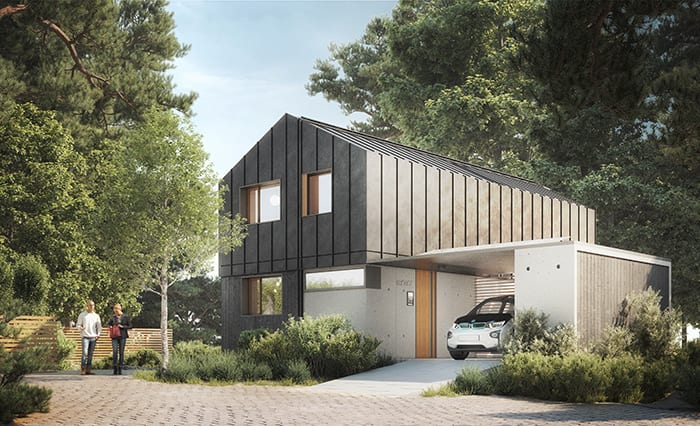Politicians are setting great store in offsite manufactured housing delivering in both numbers and quality. Momentum is gathering pace but are factory-made homes really on the road to becoming mainstream? Denise Chevin reports.
On paper, the stars couldn’t be any more aligned to nurturing a revolution in housebuilding. A post-Brexit labour market, a public outcry over poorly built traditional homes, and a government pressuring the industry to build 300,000 homes a year – they all play to the strengths of building in the factory, rather than on site.
And sure enough, an explosion in activity is taking place, with new players continuing to come into the market, albeit with hurdles still to clear. When BIM+ took the temperature in November 2017 there was considerable optimism in the market.
Since then the first houses from Ilke Homes – the modular housing business formed by housing contractor Keepmoat and Elliott Group, aiming to deliver 2,000 homes a year – are arriving on site. Tide Construction has planning permission for the world’s largest modular building in Croydon, reaching 42 storeys. Laing O’Rourke has announced a “game-changing” offsite partnership with developer Stanhope and housing association Network Homes to deliver hundreds of dwellings across the south east.
Meanwhile, regeneration specialist Urban Splash is cranking up its modular housing delivery and has bought the offsite construction business from materials giant SIG. One new player, a business called nHouse, even used crowdfunding – a construction first – to raise £1m to launch its first prototype show house at MIPIM 2018.
In another potential milestone, Berkeley Group has the go-ahead to build a modular homes factory in Ebbsfleet. The commitment from a volume housebuilder is “a significant step” says Dennis Seal, chair of Buildoffsite’s Residential Hub, who reports a surge in interest in modular housing with volumetric, steel frame and timber growing equally.
A more quantitative measure of quickening pace and appetite for disruption can be seen in the number of schemes that have been accredited by BOPAS – the accreditation scheme for homes built with modern methods of construction, which has backing from RICS, Buildoffsite, Lloyd’s Register and warranty provider BLP Insurance.
In 2017 BOPAS awarded 20 certificates – double the number in 2015. In 2018 already more than 10 have been certified, with more than 40 in discussion.
Interestingly, BOPAS sees the biggest growth in activity coming from volumetric systems, with UK manufactured products dominating (see graphs).
Country of manufacture
BOPAS registrations by country of origin

System types
BOPAS registrations by type of construction

The growth of offsite
The rise of BOPAS registrations

Jeff Maxted, director of technical consultancy at BLP, says: “The rapid growth is coming from across all accommodation sectors – student accommodation, the private rented sector and for sale.”
That’s not to say, however, that progress is entirely smooth. L&G, which has pledged to build 3,000 new homes a year from a new factory near Leeds, says it will now roll out its first homes in June. When the initiative was originally announced it had initially hoped to complete its first homes in the summer of 2016 and to have “a large pipeline” in place by early 2017.
The Aecom factory planned for First Base’s Silvertown Quays development, which had plans to build 3,000 homes, is “paused” (see below). And the most audacious plan on the scene came apart at the seams in February when Your Housing Group announced it has pulled out of its £2.5bn offsite construction joint venture with China National Building Material Company and energy firm WeLink to build 25,000 homes over five years from factories in the UK. WeLink said it planned to continue its drive into UK housing, and recently signed a memorandum of understanding with Swansea council.
Despite these blips, the prognosis for change remains bullish. Mark Farmer, the author of Modernise or Die, the report published in October 2016 calling for radical change, is certainly optimistic, saying: “The pace of change is quickening. Although many in the industry will not see or feel it, there are significant things afoot that will start to fundamentally change the way we design and build.”
This will be through a combination of two factors. First, new disruptors continuing to enter the market. And second, a seismic shift which is seeing Tier 1 contractors and some large consultants increasingly viewing “construction as manufacturing” and creating platform or system-led design approaches which break down buildings into standard components to be pre-manufactured. Examples include Aecom, Atkins, Mace, Arcadis and Bouygues (see below).
Says Farmer: “The future-proofed ones are using digital platforms and fabrication as their route to market – not the ‘cottage industry building traditionally in a shed’ approach we have been used to. Whether the industry accepts more design standardisation for manufactured components will be tested later this year by the GLA work I am doing with Bryden Wood.”

Swan Housing Group handles the whole process: modular homes are assembled in its Basildon factory, then transported to its sites to be built
Farmer, who is chief executive of Cast Consultancy, is referring to the research project commissioned by the London mayor which aims to build more flexibility into offsite. It is widely acknowledged that to maximise the benefits of design for manufacture and assembly it is necessary to agree the designs early in the process.
But although some designers would argue that this is no bad thing in a post-Grenfell landscape, it necessitates clients committing to one supplier early on, and consequent nervousness around security of supply.
Jaimie Johnston, head of global systems at Bryden Wood, says that what they are looking to come up with is a kind of design code that will suit both architects and manufacturers, which would allow design integrity and systems to be more interchangeable. “It’s a massively needed piece of work,” he says.
There’s a will in government to make offsite work, though the mechanisms could be stronger. Alongside development and innovation funds that provide incentives, Homes England is understood to be considering introducing requirements for offsite homes to be built on land it releases, or tied to any grant, providing more pipeline and encouraging investors into the market.
The government has also charged Farmer with bringing down another barrier: the resistance among insurers and lenders. The aim is to get the leading companies to agree a standard approach to certification of offsite systems.
“It is important to reorganise the new build housing assurance and warranty market and ensure more consistent, robust standards and quality-led control of modern methods of construction are put in place so we do not repeat the mistakes of the past and let systemic failures occur,” says Farmer.

Developer nHouse used crowdfunding to raise £1m to launch its modular house protoype
The other major sticking point is cost. For some providers the sums still don’t stack up – a point made recently by Joanne Roney, chief executive of Manchester City Council. “The challenges of modular are greater than hoped,” she told Inside Housing magazine. “For us the biggest barrier is finding a product that allows us to use all our available land – regardless of size – and still beat the price points of traditional build methods.” Roney said the council was still hopeful it can be done.
With construction costs higher in the south, modular is more attractive in some areas than others, though it scores well on quality and speed of delivery.
Swan Housing Group is managing to tick all those boxes, by taking all the risk itself and cutting out margins along the supply chain by handling the whole process, as developer, builder and asset manager. The Essex-based housing association has invested in a factory in Basildon to build 300 homes a year from cross-laminated timber modules under a brand called NU build.
Manufacturing specialist Paul Williamson joined Swan Housing in early 2016 to lead it. He says: “We’ve recently gained BOPAS certification and our first 10 new homes will be built by the end of the year. Because we’re vertically integrated we’re taking out costs – others want to devolve risks. I think you also have to factor in the enormous costs of remediation given the defect rate that can come with traditional contracting.”
He also sounds a note of caution – pointing out that talk of deskilling can lull the sector into believing setting up a modular housing factory is easy. “We’re taking out the handcraft from housebuilding and making the process repeatable – that’s not deskilling.”
Michael Cleaver, director at the Housing Forum, remarks: “The reality is that the impact of offsite construction in residential in the affordable sector is still limited because modular doesn’t stack up financially; it’s more expensive than traditional build.”
Steve Turner, director of communications at the Home Builders Federation, makes a similar point: “All the volume housebuilders are looking at offsite in some shape or form – but a lot of things still need to be proved before it becomes a mainstream solution. It will not lead to a step change in how we build things in the immediate future.”
This won’t deter the disruptors – nor should it. As most in the market agree, if we are to deliver 300,000 new homes a year there’s more than enough room for innovators and traditionalists.
Putting offsite to the test
As part of the three-month Great Exhibition of the North in Gateshead, starting this month, housing association
Home Group is developing a site called the Innovation Village, which will trial five modern methods of construction, three heating systems and a range of “smart technologies”. It aims to assess different construction approaches for its planned programme of 10,000 new homes between now and 2022.
The whole project is an exemplar of how quickly homes can be built if the will is there, says Brian Ham, Home Group’s development director.
The pilot will see 41 homes constructed, of which 36 will be from offsite methods. Of these, 16 are volumetric, supplied by three different manufacturers, nine are from a panelised light steel frame product and 10 are to be made from aerated concrete panels.
The scheme went in for planning permission in January and started on site in March, with the homes expected to be completed by the end of the year. It will be monitored by the BRE during construction and occupation.
Cutting out contractors? Consultants and manufacturers buddy up
A potentially disruptive trend in the offsite sector is the emergence of new partnerships between consultants and manufacturers, or consultants and developers – potentially cutting out the contractor “middle men”.
One of the most ambitious of these players is Aecom, which has teamed up with Rogers Stirk Harbour & Partners to design a factory-made housing system, taking on board lessons from schemes they have worked on together, including homes for the YMCA.
However, the widely publicised partnership with First Base, announced in April 2017 to deliver 3,000 modular homes from a factory in east London as part of the £3.5bn regeneration of Silvertown Quays, is on hold – pending discussions around construction finance and potential new owners.
Starwood and Lendlease are said to be in the late stages of appraising the 25ha site, and in April it was reported that Indian developer Essel had made an approach to purchase it from current developer the Silvertown Partnership – a consortium of Chelsfield Properties, First Base and Macquarie Capital.
Relationships with First Base remain excellent, says Peter Flint, chief executive buildings and places EMIA at Aecom, though the project has “gone quiet” for the moment.
Aecom, meanwhile, has established a factory in Newark where it is building a prototype which will see 95% of each unit fitted out in the factory. The lightweight units use timber frame with a lightweight steel exoskeleton and Aecom is working with the University of Sheffield Advanced Manufacturing Research Centre to streamline the production process. One unit will form a one-bedroom flat; two units will make a two or three-bedroom apartment.
“There is lots of market interest and at this stage we’ll act as design and build partner to clients,” says Flint.
The production line can produce 250 units a year – with extra production lines coming on stream if demand increases. Looking ahead, Flint says Aecom may well set up regional factories to get around transportation issues.
“There is certainly no shortage of people wanting to buy into our approach,” he says. “We can see half a dozen really big players in this space which will be transformative for the industry.”
Other consultants are also hoping to make their mark, though plans are embryonic. In November consultant Arcadis announced it was working with offsite specialist Caledonian to design and make modular housing. The idea is that Arcadis’ support in design and construction management will allow Caledonian to focus on manufacturing and delivery.
Also dipping a toe in the water is Atkins, which is entering the residential market with a product it hopes to develop in partnership with local authorities to provide affordable homes. These will be built from a kit of parts designed by Atkins and manufactured in China. Called MetroHome, it can be configured to suit layouts including detached, semi-detached and town houses.
Using the MetroHome concept Atkins is working with the London Borough of Lambeth to deliver four two-bedroomed homes scheduled for completion this summer.
Comments
Comments are closed.














Hi Denise,
What a great round-up on what’s happening around offsite and modular. Shared on LinkedIn as well as with my group of consultants in the Circular Economy. Offsite and modular are great pathways to circularity and its a really exciting time for change in design, construction and sustainable asset management.
Thank you, August.